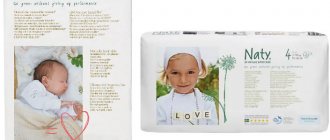When a baby is expected in a family, future parents think about what the baby will need in his daily life, what household items need to be purchased for the birth of the baby? How to choose the best for your child? What does a newborn really need, and what can you refuse to buy?
Indeed, when a family is expecting their first child, it is very difficult to navigate the variety of things that are presented on our market specifically for newborns.
Each advertisement states that this item is simply vital for the baby; there is no way to do without it! But this is not always the case.
There are a huge number of products for children that are not vital for a child. And in certain situations, you can completely refuse to buy these things.
A bathtub for a newborn falls into the category of household items that are not essential for a baby.
Of course, bathing is a very important process, which allows not only to keep the baby clean, but also allows for the development of his psycho-emotional sphere, helps eliminate muscle spasms, including spasms that occur in the tummy, and improves physical development.
So why then might a newborn bath not be necessary for your baby?
If you live in a comfortable house with a centralized water supply, then you have a stationary standard “adult” bath. This same bath may well be suitable for bathing a newborn baby.
The fact is that if you have a central water supply, you do not need to boil water to bathe your baby; tap water will do.
If your baby does not have skin problems (no various rashes), then you do not need to add potassium permanganate or any herbs to the water, which means you will not damage the enamel of your bath, as most authors write about in their articles about baths for children. newborns.
One adult can easily cope with bathing a baby, tested on himself and his two children; do not listen to those who say that without a special bath you will not be able to wash your child alone. This is not true, after a couple or three baths, you will get the hang of it and feel quite confident.
Yes, bathing a baby while leaning over the bathtub is a little hard on the lower back, but you can sit on your knees in front of the bathtub and then it will be easier for you.
Or you can purchase a separate anatomical slide for bathing babies with suction cups; it will fit quite well into your bathtub and free up your hands and back, since the baby can be comfortably placed on it.
Slides come in plastic, fabric on a frame, mesh on a frame, inflatable mattresses and sponge bathing molds. Sponge bathing forms are the safest and most enjoyable for your baby. Some types of slides cannot be installed in a regular bath; they are designed specifically for children's baths!
By the way, you can use this slide on those days when you are going to wash your baby with a bathing product (you can use soap or special products when bathing no more than 1-2 times a week!), and on other days you can bathe your baby without it, which will give him the opportunity to swim freely!
To ease the burden on the parent when bathing, if you want the baby to swim and not lie in the water on a special device, you can purchase a circle around the baby’s neck for bathing. This device is intended for children from birth, and it will allow you and your baby to frolic in the water without getting tired.
Thus, a stationary “bathtub” is quite suitable for bathing a newborn baby, and in addition allows the baby to swim freely, which cannot be done in a baby bath.
There are, of course, a number of disadvantages to such bathing - keeping an “adult” bath clean is a little more difficult, in terms of spending more cleaning products, and more water is required to fill a large bathtub. In general, the shortcomings are not significant. But the benefits of swimming are much greater! In any case, the choice is up to you, dear parents.
There are situations when you simply cannot do without a special bath for a newborn!
- If you live in a house without a centralized water supply. There are two reasons to buy a baby bath - you don’t have an “adult” bath, and, most importantly, you have water from a well, well, spring, etc. That is, water that does not undergo purification and disinfection. This means that you will have to boil it to bathe your baby! It is much easier to boil a bucket of water for a baby bath than for a large one.
- If you simply do not have an “adult” bath, for example, you have a shower, then you will also need a baby bath for bathing a newborn.
- If you live in a dorm, then, of course, you will need a baby bath.
- If you go to the countryside in the summer or for a long vacation to the sea, lake, or river, then having a baby bath is also necessary (here you can take a folding version of the bath or an inflatable bath; more details about the types of baths for bathing newborns are below).
And, of course, if you think that you need a bath for your baby, then you need to buy it! It’s never too late for your baby to “move” for a swim in an “adult” bath!
Does a newborn baby need a bath?
Many mothers ask the question: “Is a bath really necessary for bathing newborns or can you get by with a regular bath?” The child, of course, needs an individual bath. Parents can do without it, but it will be much more difficult for them when bathing their child.
Is it possible to bathe a baby in a shared bathroom?
Each mother decides for herself how it will be convenient for her to care for her baby. You can read the recommendations, but your own opinion is formed in the process of practical skills. Bathing a baby in a shared bath is not contraindicated. The problem may be that it is much more difficult to clean a shared bath before bathing (required!). And also, if there are problems with water supply in the house, then it will be difficult to collect a large amount of water.
Choosing a baby bath
Let's look at the basic principles of choosing a bath for bathing a newborn:
- Certificate of quality.
Be sure to ask in the store, the bath must be made of high-quality, non-toxic materials!
- Absence of any defects.
Cracks, chips, scratches, and dents are not allowed.
- The surface of the bath should be smooth, without roughness or splinters. But it should not be too slippery so that the child does not slip in it.
- The bottom of the bathtub for bathing a newborn should have a non-slip coating or non-slip feet. This is necessary to ensure the safety of the baby when bathing; the bath should not slip on the surface on which it is installed!
- The bath should be light. The mother, on whose shoulders the entire care of the baby falls, should effortlessly lift and turn the bathtub, as this will be needed when cleaning the bathtub itself.
- It’s good if the bath has a drain, then it will be easier for you to drain the water.
- The bathtub should be able to be installed on a bathtub stand or on the sides of a stationary “adult” bathtub. This will allow you to avoid leaning towards your baby while he is bathing.
- Modern baths may have additional functions - a water thermometer, for example, this is acceptable, but not necessary, as this increases the cost of a baby bath.
Well, before purchasing, you should definitely decide for how long, that is, until what age of the child you want to use the baby bath.
If a bath is required only for a newborn for the first one, two or three months, then any size of bath that is on the market will suit you. If you need a bath for a longer service life, then pay attention to the capacity, length and width of the bath.
Types of baths
Today there are several types of bathtubs on the market designed for bathing newborns. This:
- anatomical;
- classic;
- inflatable;
- antibacterial;
- installed in bathtubs and showers.
Let's look at each of them separately.
Anatomical
They are a plastic structure with a built-in anatomical slide, which provides reliable support for the baby, preventing him from slipping. Fixation of the newborn occurs due to the indentations in the slide for the armpits, legs, head and butt.
This option is most popular among young families, since bathing the baby is possible alone, without the help of a second adult. And besides, bathing a child in it is convenient even at the age of 6–8 months, when he begins to sit firmly. For this purpose, the bath has a special recess under the bottom, into which the baby is placed.
Classic
This option is a small plastic replica of an adult bathtub. It does not have built-in slides or other devices for securing the baby, so it is impossible for a child to bathe in it alone. After all, someone needs to hold him. But this option is budget-friendly, since it is the cheapest on the market and has various shapes, sizes and colors.
Useful: Which diapers should I choose for a newborn?
A classic bathtub can be installed on a wooden grate in an adult bathtub, placed on chairs or on the floor. It is light in weight, so carrying it from place to place will not be difficult.
Inflatable
Inflatable baby baths appeared on the Russian market not so long ago, but they have already gained popularity. They do not take up much space and are the best option for small apartments where there is no free space to store regular children's baths. Just wipe it after bathing, blow it off and put it away.
They have different colors, shapes and sizes. There are also improved inflatable baths that have a built-in inflatable anatomical slide. However, their price is significantly higher than their counterparts. The simplest option without slides costs from 600 to 2000 rubles. Those that have built-in anatomical slides cost much more - from 2,000 to 15,000 rubles.
Antibacterial
Such designs are no different in appearance from classic children's baths. Their only difference is the antibacterial coating, which prevents the formation and accumulation of bacteria.
This option does not require additional care. They can additionally have built-in water thermometers, recesses for bathing the baby, as well as drain holes.
When purchasing such a bathtub, you need to pay attention to the location of the drain hole. It should not interfere with the baby during water procedures and should be in his sight, because as soon as the child grows up, he will begin to open the plug, the water will drain, and then swimming in it will become impossible.
Installed in bathtubs and showers
These types of bathtubs for bathing newborns have fasteners at the base, with which they are fixed to the surface of an adult bathtub or shower, which prevents them from slipping. They are convenient because there is no need to carry warm water or drain it in buckets, and in order to bathe the baby, you do not need to bend over, which is also a big advantage.
Theoretically, you can bathe a baby in an adult bath, but this is not very rational and is not always safe
What are they?
The manufacturer allows parents to independently choose the type of bath that is suitable for their child. Products can be anatomical, classic, built-in, inflatable or designed according to the “mother’s tummy” principle. Each of these types is good in its own way, but each also has disadvantages.
READ ALSO: How to properly install a clawfoot bathtub?
- Anatomical bath . One of the most popular options today. It has a built-in swim slide that acts as a support under your back. It prevents the body from completely sliding into the water. The bath allows you to follow the contour of the child's body, and the head is constantly above the water level. Therefore, only one adult can bathe the child, and there is no need to support the body with one hand. The same bath will be appropriate for children who have already learned to sit, since their legs rest against the support and do not move apart. However, this bath also has a disadvantage - there is no way to place the baby on his stomach, so it is difficult to wash his back.
- "Mom's tummy" . It has a bowl-shaped shape and high sides, thanks to which, when bathing, the baby takes the same position in which it was inside the mother’s belly. This way he feels protected again, and the muscles of his body relax. Suitable even for those children who do not yet know how to sit and hold their head. There are special marks on the side for the water level, the temperature inside the bath is kept at a constant level for about 15 minutes. Sometimes pediatricians recommend bathing in such baths to relieve colic or neuroses. The downside is that it’s a rather unusual shape that you just need to get used to.
- Classic shaped bathtub . The most popular are oval baths, which are sold in every children's store, have many colors and a wide price range. Easily installs on a table, chairs or inside a large shared bathtub. However, you cannot bathe a child alone in it; a second adult participant must support the head while another soaps and rinses the child. There are no supports for the legs and head.
- Baths that can be installed on a common bath . This type appeared not so long ago. And the point of the product is that it is easily attached to the sides of the bathroom using special fasteners. It is very convenient that parents do not have to bend over much while bathing, since the water procedures take place approximately at the level of their waist. The size of these baths is small, but close to standard. However, before you purchase it, you need to make sure that this particular bathtub is commensurate with a large bathtub. The downside is that the structure is unreliable - you need to screw the fasteners very tightly so that it does not fall under the weight of the water.
- Baths installed in shower cabins . They are small in size, equipped with a seat and have their own drain. The best option for those children who can already sit, but will not be able to bathe a newborn in it. Such designs can be used both in the home shower and outside, for example, for swimming in a summer cottage.
- Baths with temperature control function . It already has a built-in thermometer and a soap dish, and also has a special non-slip coating. There are legs that allow you to place the bath comfortably both on the table and inside a large bathroom. It has its own drain hidden inside the thermometer, which means the child is not able to pull out the plug on his own.
- Inflatable baths . Can be an ideal option for outdoor recreation. In some cases, it can even be used as a mini-pool. A big plus is its compactness, since it can be deflated and folded, and this is very important in a small apartment. The kit includes a special inflatable pillow for the child's head. There are valves, but the baby will not be able to open them on his own. A significant disadvantage is that it is very easy to spoil simply by punctures.
- Antibacterial baths . It is made of ordinary plastic, but is coated with a special antiseptic coating. It's called microban. This coating helps destroy pathogenic bacteria, so the bath does not need to be treated with a bactericidal solution after each bath. This is very convenient, since cleaning products often cause allergic reactions in children.
- Bathtub built into pieces of children's furniture. It is usually placed in a chest of drawers. The drainage system is equipped with a hose. This allows you to avoid carrying swimwear from the large bathroom to the child’s room every time. At the end of the procedure, the bathtub and changing mattress are removed, and the furniture again acquires its original functionality. The big disadvantage is that the child grows out of it very quickly.
READ ALSO: How to choose a wooden bath seat?










